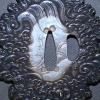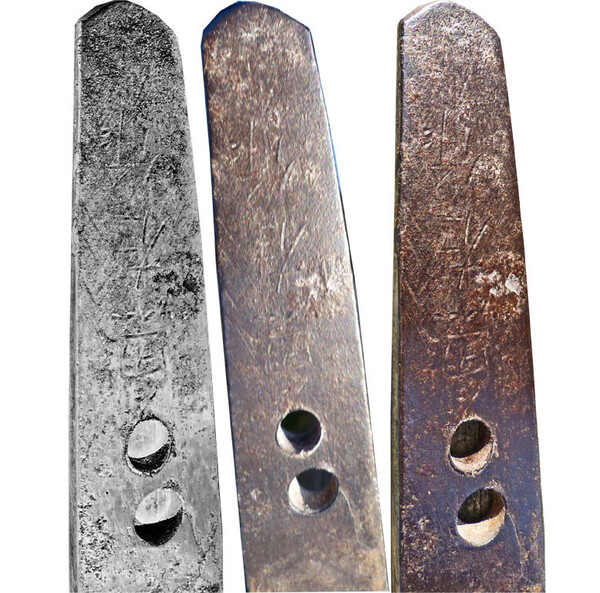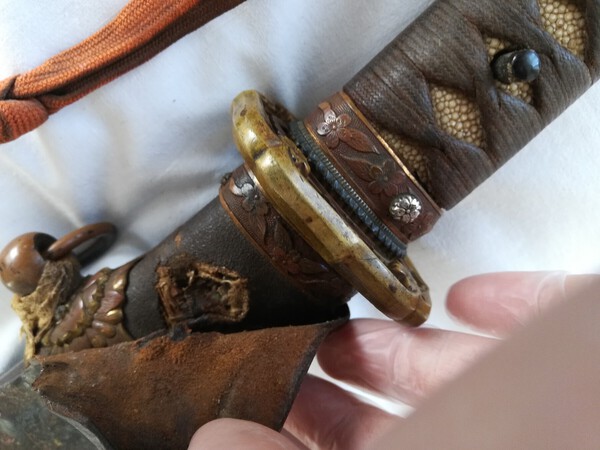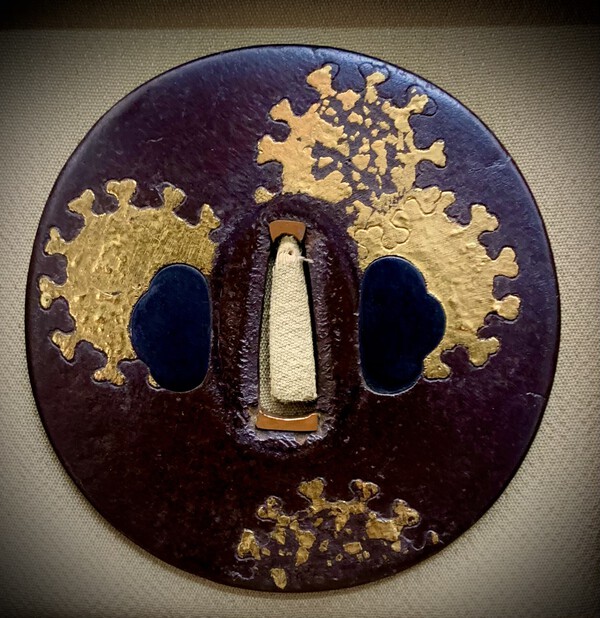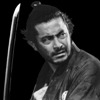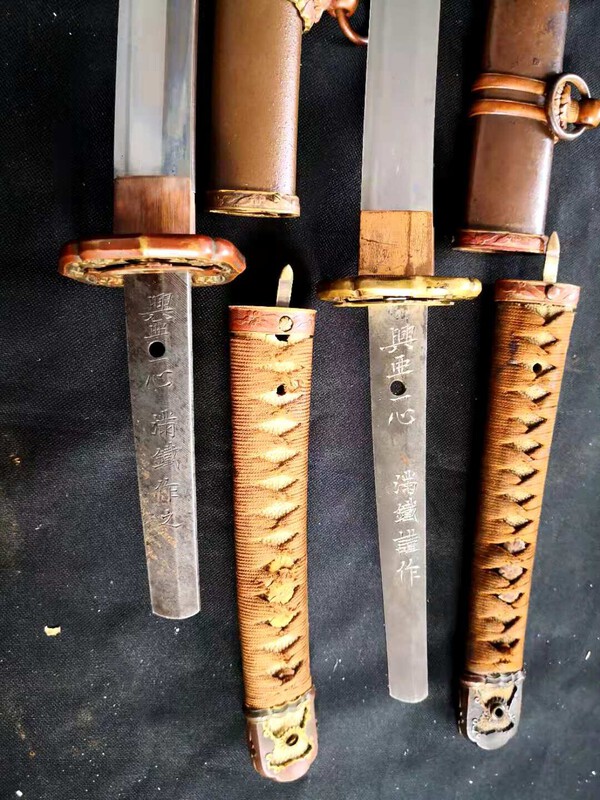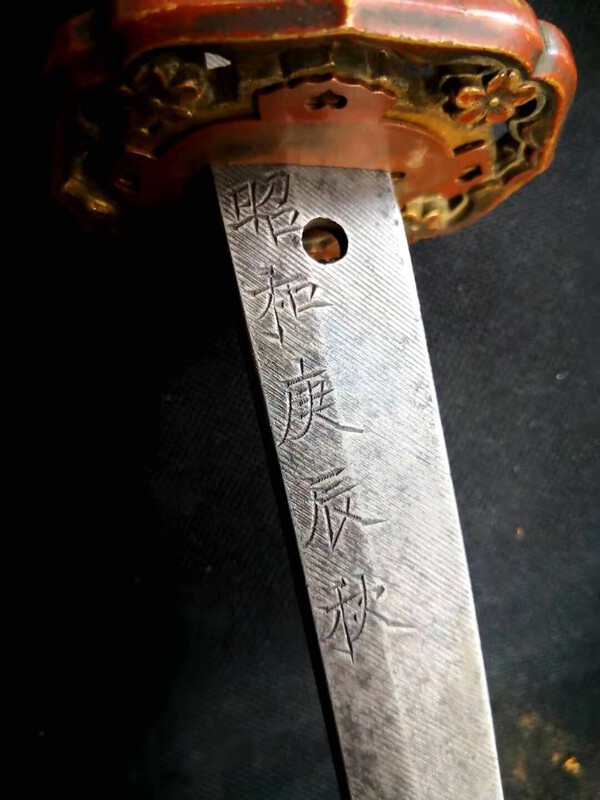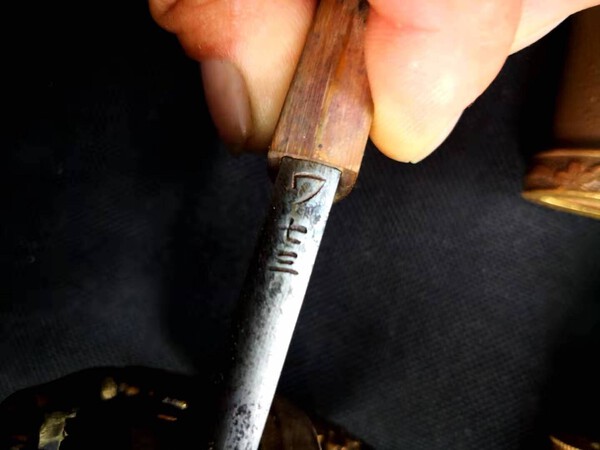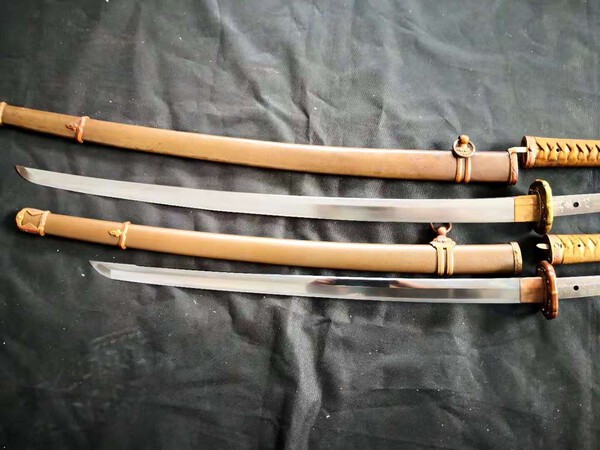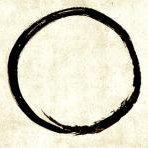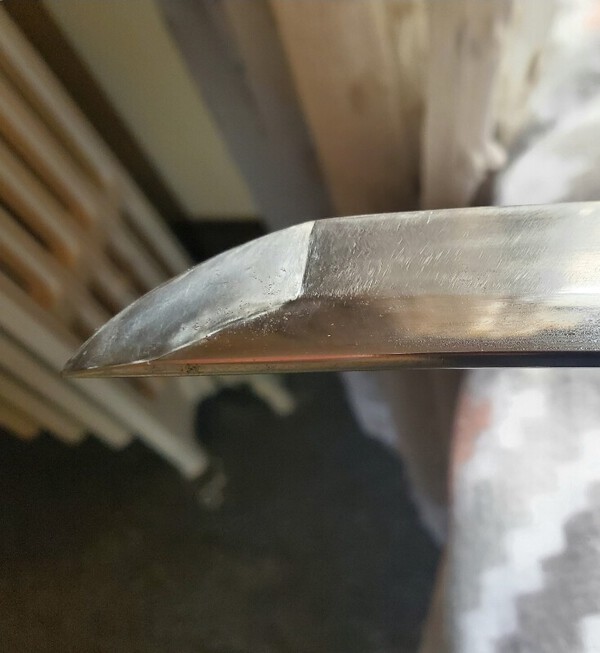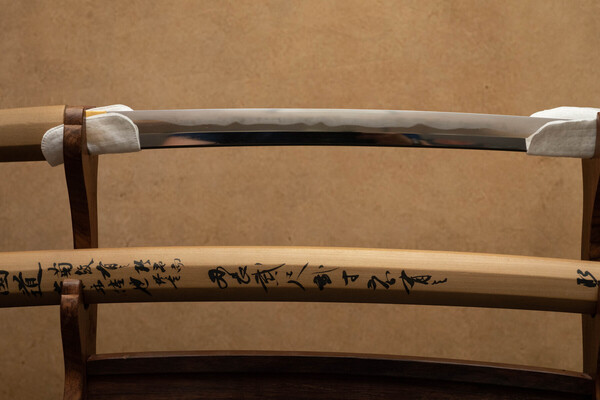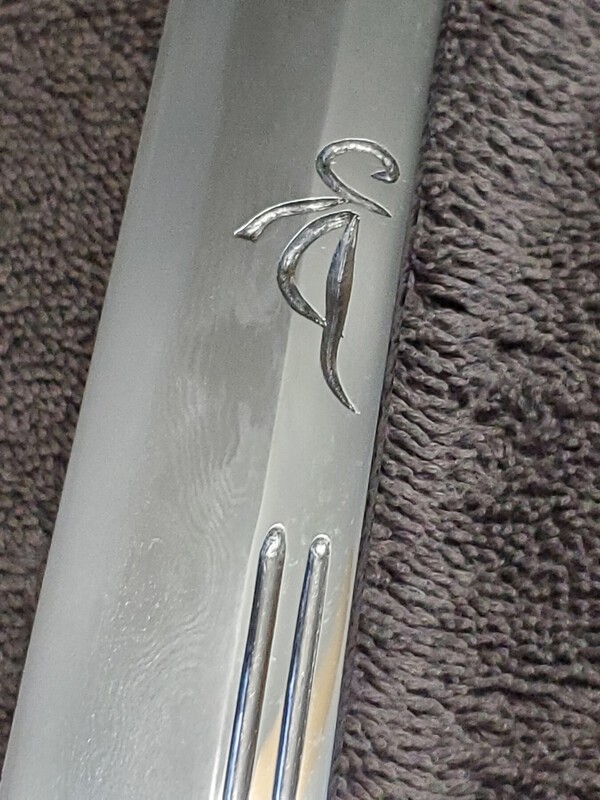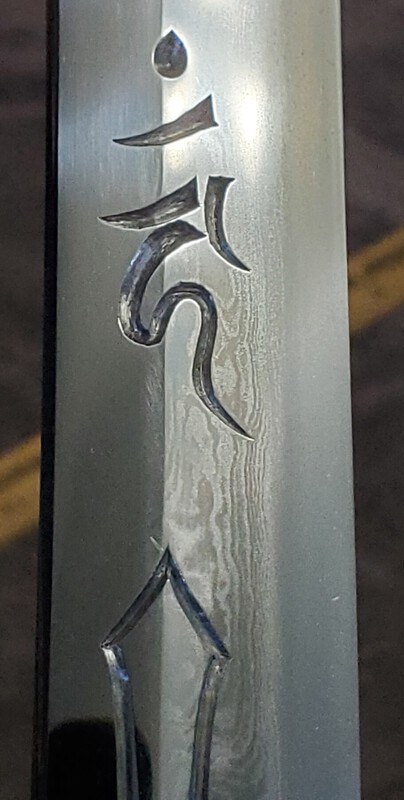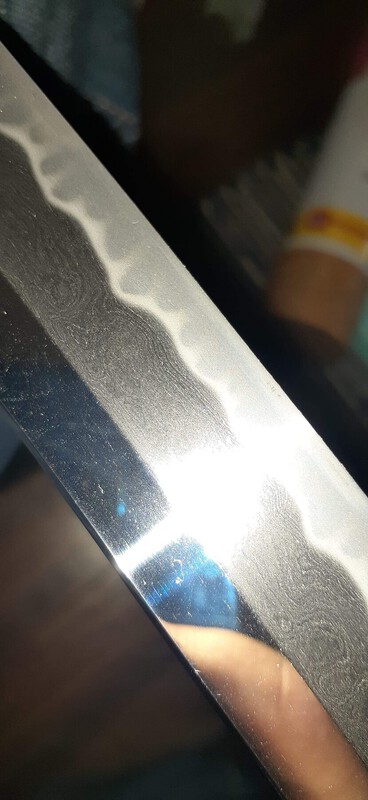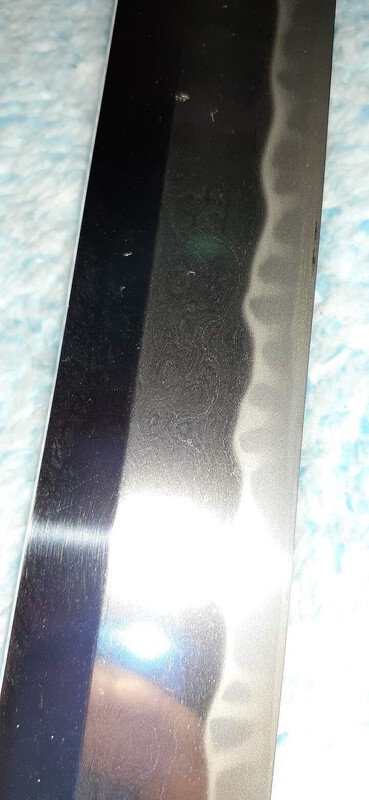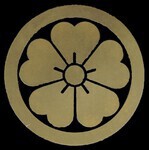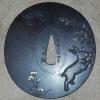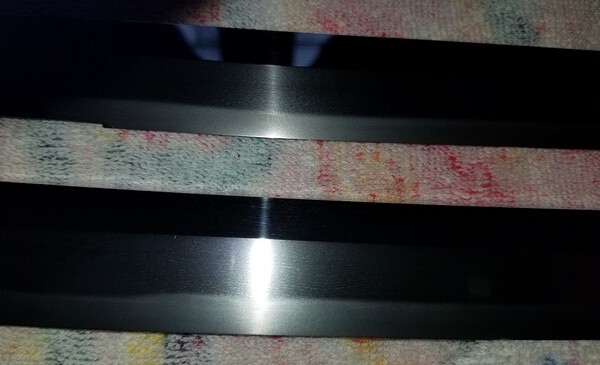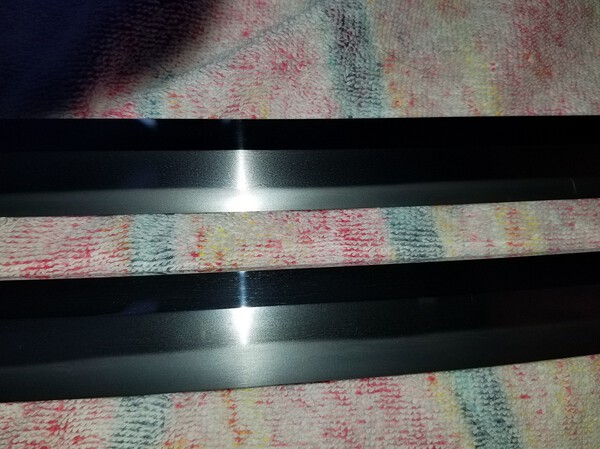Leaderboard
Popular Content
Showing content with the highest reputation on 11/12/2020 in all areas
-
Malcolm was recently offering some mekugi-nuki for sale; this prompted me to search around the house and do a historical shot. Five are Shinchū. The oldest one is in separate pieces and could well stretch back to the Edo Period. (The two iron ones are probably specifically for matchlocks. They can also act as a key to turn a Bisen breech screw.)4 points
-
Some nuggets: Late muromachi, Seki methods spread and dominate during Shinto times, leading to loss of school-level variations. Brief Momoyama effort to resurect the old methods, fades quickly. Some of it lives on in Hizen in a parallel universe. Shinto peace times reinforce the non-utilitarian aspect of swords, craft is driven by fades and fashions which are disconnected from function. Centralized Tamahagane production leads to loss of regional specificity in iron Reduction in demand for swords during Shinto times leads smashes the right tail of the distribution of geniuses which would have turned grand-masters. Shinshinto Masahide revival starts from scratch after observations that swords are no longer functional. Two generation, destruction test on Naotane swords reveal that the Masahide school wasn't successful in returning functionality. Mozart Kyomaro manages to reproduce some of the beauty of old Koto but then dies young and full of debt. Sword ban strangulates the craft even further... Amongst all these, I think the most underrated is probably 5.3 points
-
Have consigned two of my swords to Shoubudou to help me sell. Details and high res photos and videos are available in the following links: Tokubetsu Hozon Yoshioka Ichimonji Katana https://www.shoubudou.co.jp/products/detail.php?product_id=157 Tokubetsu Hozon Inoue Shinkai Wakizashi https://www.shoubudou.co.jp/products/detail.php?product_id=158 Feel free to let me know you are interested, I can work on the pricing if keen. Submission to Juyo shinsa can be arranged if required as both swords are in Japan. The submission window for this year's Juyo shinsa is 16th-18th Nov. Will make a donation to the board if it sells to any of board members too, thanks!2 points
-
2 points
-
The character is the hiragana character と (to). Thus the serial number is と 三七四 [to 374].2 points
-
I agree with Michael 100%. Shinsakuto can be used in sword appreciation and martial art training or combat (but yea, gun is more effective to kill your enemy in combat and hopefully we never have to confront any life and death combat during our life) while antique swords (mainly swords made before the Showa era or swords made by swordsmiths who have deceased) should only be preserved for sword appreciation and be regarded as important artworks and historical artifacts. It is actually good for modern swordsmiths to continue to make Nihontos for martial art practice. The customers who seriously practice martial art can give the swordsmiths valuable feedback to ensure newly made Nihontos are still practical for combat. If modern swordsmiths stop making Nihonto for martial art training/combat, they would focus too much on making "fancy" art swords and forget the practical elements of the sword (for example, general shape of the sword, balance of the sword, weight, curvature, and the balance between sharpness and durability). If the swordsmiths of the current generation and the following generation stop to make practical Nihonto, the true art of Nihonto craftsmanship would be lost and the future Shinsakuto could only be considered as "sword-like artwork". But on the other hand, JP's concern is understandable. It is always sad when swords are damaged during martial art practice. For example, a sword could be bent during a failed tameshigiri practice. This kind of incidents should always be avoided. And that is why, in martial art training, Shinsakuto should only be used by serious and experienced martial art practitioners who have the right and mature knowledge about how to take care of their swords. And of course, martial art practitioners should always be careful not to hurt themselves. All of these being said, please enjoy watching this video about Yoshindo Yoshihara made a sword for a martial art master to test the sword's strength when dealing with a Japanese helmet:2 points
-
2 points
-
Brano, not convinced in getting Tanobe sensei sayagaki on this sword. Save the request for something else.2 points
-
Tom, I merged that account with your old one. You can edit your display name back to Toryu if you like, and use the same avatar.2 points
-
I love sword maker tsuba BUT it needs to be more than just a signature it has to be a good tsuba first... -t2 points
-
2 points
-
2 points
-
(DISCLAIMER: the following is just meant to answer the OP’s question in the most unfair, dishonest way and shouldn’t be taken literally. What the previous posters say about Koto swords is true and this shall only be taken as a caustic reply in which most, if not all is exaggerated!) Soooooo! What makes Koto swords so desirable? Let me be, for a moment, the fly in the ointment! 1) TRADITION: just as everything was “better before”, so it is with swords. Japanese swords were made by a very rigid society that engendered a rigid hobby. So obviously, past and venerable techniques are necessarily better than newer ones, even if, at the time, they were only dictated by what swordsmiths had at their disposal. 2) PRIDE: have you ever heard someone boasting he’s driving a Peugeot? Nope! People who drive Ferrari do! Same here! It’s always more delightful to awe somebody by saying:” I have a 700 year-old sword” than: “I have a 70 year old sword”. The worst of the shame being : “I have a Chinese wallhanger!” 3) SLOTH: let’s face it, Koto swords are easier to study than Shinto swords. Learning about 5 traditions is always easier than learning a multitude of traditions. 4) FAKE NEWS: everyone knows Kamakura and Nambokucho swords were perfect! No, really! They had beauty, grace, efficiency... wait? Efficiency? They were so practical and efficient that they had to be suriage during the Sengoku era to be useful in battle. 5) SIZE MATTERS: Everyone knows Shinto swords are useless because they weren’t made for battle but to display showy qualities. Not so with Koto swords! Eeeerrr! What about those Nambokucho swords where samurai from the Southern and Northern court fought to see who had the longer one? I mean the sword, right? Isn’t that being showy? 6) SCARCITY: actually, this is my only serious argument, so no joke here. Most of the swords on the market today are Shinto swords. It’s logical. After all, they are more recent, didn’t experience real battle, so it is normal that we find an array of swords ranging from bad to excellent. Now, the early Koto swords are more scarce. It’s logical too. They’re older so had many more opportunities to be lost, destroyed, whatever. So it’s also logical to postulate that most of those that survived were cherished family swords of quality. If this is the case, we can also postulate that many swords of lower quality disappeared in the maelstrom of time, leaving only the upper quality swords. Thus, those Koto swords we have are truly better than the more recent ones because the good ones are the only one left! Once again, anyone feeling piqued by my post, please read the disclaimer and realize this was written with a very humorous effect in mind! Please don’t send an evil ninja to exterminate me! In the end collect what you like and attracts your eye until you stumble upon your own personal treasure.2 points
-
Bruce, I updated the post after the fact and that is why you missed it. It took some time to find the Mantetsu 13 series swords that BangBangSan was looking for. Thankfully, Stegel-san reposted those tachi pictures which had serial number ワ 一三四.1 point
-
Ubu-ba is typical for gendaito, and gendai often remain ubu-ba after their next post-war polish unless there is significant rust or damage that needs to be addressed.1 point
-
Hi Barry, That's a great technique, applied crisply and with loads of kime, in my case, I mostly end up flat on the floor!! Still what do they say? "Nana korobi, ya oki!" 🤪1 point
-
ワ 六 = WA 6 No pictures. http://ohmura-study.net/222.html ワ 一三四 = WA 134. https://www.militaria.co.za/nmb/topic/28631-railway-swords-stamps/?do=findComment&comment=290148 ワ 一五八 = WA 158. https://yakiba.com/Kat_Mantetsu4.htm https://www.militaria.co.za/nmb/topic/26165-attention-mantetsu-owners-a-survey/?do=findComment&comment=2655121 point
-
Robert Hughes may be able to help but he usually handles it for swords when he is acting as agent. Not sure as he is not in possession of the sword. Sounds like someone will have a lot of work picking it up or receiving it then getting it done then getting it back to whomever.1 point
-
The Mantetsu 13 ワ series is a bit of a toss up as far as dates are concerned. An unusual amount of custom swords also make an appearance. At this early date, all are commercial blades. In summary, this is what shows up. 1941春 ワ 六 Details unknown. 1940秋 ワ 三三 Wakazashi. 1940秋 ワ 七三 Wakazashi Type 98. 1941春 ワ 一三四 SMR Tachi. 1941春 ワ 一五八 Type 981 point
-
1 point
-
1 point
-
1 point
-
Really not sure about the first kanji but I think the second is saki. All the best. Edit, John beat me to it.1 point
-
Hi Dave, it’s signed “Kanesaki”. Maybe one of the Inaba ones? Anyhow, doesn’t use the abbreviated form of this “Kane” character so that should help to pin it down.1 point
-
I see a coronavirus Tsuba. I see interesting similarities between snowflakes and family Mon.1 point
-
1 point
-
1 point
-
I believe this is a four character idiom - unfortunately the fourth kanji indecipherable to me... https://en.wikipedia.org/wiki/Yojijukugo1 point
-
Looks like 兼定 (Kanesada), with a slightly funky 定. I don't know how many swordsmiths there are named Kanesada, but probably a dozen or more. You would have to look up all the Kanesada smiths and try to match the signature - unless there is someone on this board who recognizes the smith. The sword is in bad shape. The rust, the chip in the cutting edge, and loss of the yokote, can all be repaired by a trained sword sharpener, but my guess is that the repair job would cost more than the finished item would fetch on the auction sites. It depends on what is hiding under the rusted surface. Don't attempt to polish it yourself or you will surely ruin the sword. It needs a professional to fix its flaws and reshape the yokote, etc... If it has been in a fire, it may not be salvageable, even with a polish. This is a very difficult class of item, because on the one hand it is an authentic Japanese sword, but on the other hand there are a ton of these problematic swords on the market, and the effort required to repair it and appraise it, is often more expensive than its worth (in purely financial terms).1 point
-
Have you tried Japan Today? I've never been asked for a subscription. You can post comments on articles there too, if you sign up. To tell the truth, when I agreed to the above feed here on NMB, I mistakenly thought it was Japan Today! (The only major downside to Japan Today is their moderators who seem to work under the weirdest, narrowest rules you could imagine. Oh, and their swearword filter which is on a hair trigger, leaving you to scratch you head trying to work out which innocent word might have set it off. )1 point
-
1 point
-
1 point
-
Okay, an update, and thankfully it should be the last one. UPS just notified me that the package was officially cleared by USFWS this morning (and I have the paperwork to prove it). @Brian I did find those other threads, thank you for sharing them, and thanks to all who have contributed to this topic over the years. And now hopefully I can add this insight to the mix. The amended invoice I submitted contained the following information re: the samegawa: Handle is wrapped in stingray skin (shagreen). Genus: Dasyatis Species: Dasyatis pastinaca Source: U; (This item is approximately 36 years old.) <-- ['U' is the USFWS code for 'unknown', which is most likely what will apply for shipments like ours because there's no way to know how the animal was obtained.] Country of origin: Japan This is the invoice that the USFWS used to clear the package and the genus/species they noted on the clearance form. It was truthful to the best of my ability. That said, after more research I now believe the actual species may be Dasyatis akajei. Everyone should note that this particular species is currently listed 'near threatened,' which is something to keep an eye on in the future. If that status changes for the worse, it could become impossible to import modern samegawa, and difficult/risky to import antique samegawa. All of this is of course only in reference to the USA. Thanks all for your help.1 point
-
Try these: https://www.militaria.co.za/nmb/topic/1860-importingexporting-and-customs-queries-and-advice/?tab=comments#comment-172225 https://www.militaria.co.za/nmb/topic/16514-item-held-up-in-us-customs/?tab=comments#comment-172224 https://www.militaria.co.za/nmb/topic/12696-samegawa/?tab=comments#comment-131417 https://www.militaria.co.za/nmb/topic/24789-soon-to-happen-declaration-for-importation-or-exportation-of-fish-or-wildlife/?tab=comments#comment-2509091 point
-
100% this. I did end up finding a shinsakuto in the end. It’s in iai koshirae with a batto polish. Totally setup for martial arts use, from the beginning. Guess some of us will just have to agree to disagree. That’s okay.1 point
-
Gentlemen - There is no difference between a properly trained westerner and a properly trained Japanese employing a Shinsaku-to for Iai or batto. If you visit AOI arts and other websites you will see swords, mostly Shinsaku-to but sometimes antiques specifically outfitted and sold as ready for Iai. While I know of no secret short-cuts used to make shinsaku-to for practice I know that swords made as art swords are made using the best materials and extra effort that is reflected in the selling price. I think Michael has the right attitude, this simply may not be the best place to find what he is looking for. Antiques should not be used for destructive practice and that has not changed. I wish him luck in his search. -tch1 point
-
You might be on the right track now that i study it. It'll be off to the polisher soon to see what can be done. This is my 5th nihonto and i might have made a mistake for the first time in 10 years. Luckily it was only in the hundreds of dollars . I still feel it will turn out well after polishing. I do have some gems though. Found in deplorable shape from WW2 and sent to Japan for restoration. Papered as Yamato no kami Sukemasa NTHK.1 point
-
I don't see a problem using shinsakuto for martial arts. Interviews and videos of swordsmiths say they regularly have Japanese customers who buy their swords for martial arts. There are smiths today who make swords specifically for martial arts use. The Komiya family today is well known for making swords for battodo. Of course a martial arts swords will be slightly cheaper because of the lower polishing cost. A well made shinsakuto will have the qualities inherent in nihonto since its invention - must not break, must not bend, must cut well. A martial arts blade can be "retired" and have an art polish applied to it later.1 point
-
Looking for dirty old blades is still very much alive, because behind the dirt there is sometimes gold. In terms of knowledge, an old rusty blade or a blade with a perfect polish makes us progress just as much, but differently. We will be attracted by different details on one or the other, because of the good readability of one, unlike the other. Personally I alternate my purchases between blades in good condition and tired blades.1 point
-
George, wow and thank you. Sumo wrestling toads...I'm a fan now. John, here is the best I can do with a cellphone that fights against close shots, an old polish and choji oil (i think i use too much). The boshi is hardest to capture but is visible in perfect angles as the kissaki has taken the most brunt of time, but here's what I've got.1 point
-
Valric, thank you for the feedback and advice. I also appreciate what you shared on Kanemoto. The way you worded it added some cool on the ground level that many rewrite ups lack. Gives it some humanity rather than pure academics. The tsuba I had assumed was more like a $150 tops tsuba so your, French and Pier's answers validates that. It depends on your definition of hoarding and circus freak blades. I have 8 swords, two papered, four guntos (all type 98 two being early), a 1500's Kanekado with 2 ato-bori horimono and one Ko type 32. Ive sold four swords including a second Ko 32, a 1930's ww2 era blade with bohi, horse themed early edo sword, and a muromachi blade with leather gunto saya and made a bit of money on all of them. Now I also have this wakizashi that all in cost me $680. For a blade with these bohi that I really like, an interesting hamon, some real age, full koshirae and an old imperfect polish and probable old gimei that im ok with. I actually think I've done very well with what I have and what I've spent which by the way is an actual challenge. I lived 8 years in Tokyo, Japan, graduated from Jochi/Sophia University, worked for a Japanese International film festival for many years and tend to visit once every four years. Sadly didn't have an interest in swords during that time but have seen many in museums there. My relationship with this hobby currently is just that I refuse to spend say $3,000 on a single sword. I can tell that I'm in a bracket that this forum isn't quite for and can wear ones welcome down quickly if you actively stick around in a pre-well learned "lower bracket" blade phase. I understand that as it can sometimes be like a child interjecting themselves at the adults table. I feel safe amongst the gunto guys though. I do strive to be better. Will continue learning and upgrading my collection and for now I buy in a price range that I will never lose money as I do it.1 point
-
Truthfully I don't see it as a debate in the first place if everyone understands the semantics the same way. Your idea is totally valid. It really is a personal choice that is based on priorities, budget, and many other factors. I would never use an antique nihonto for martial arts. A shinsakuto made specifically for that purpose however is simply another tool. As I and others have said, plenty of shinsakuto exist or are commissioned specifically for martial arts use. For example, this sword was likely made with martial arts in mind: https://www.toukenkomachi.com/index_en_tachi&katana_A030720.html It's in a 'batto polish,' iai koshirae (no shirasaya), and has ubu-ba. And with a quick search you can find art swords made by Ogawa Kanekuni that were never meant to be used. This daisho that Joe posted definitely was not made for martial arts use: http://sanmei.com/contents/media/A58786-7_S2229_PUP_E.html?fbclid=IwAR3sIBjfH4045wDc7niYzgdwkTW2EaOWYfbDk-HN4gaYe59_9Wq-f5EoB6M And here is a sword made by the same smith who made the daisho that absolutely was intended to be used: http://www.osaka-ryujindo.jp/Table/Page/201404/23154330/index.html?fbclid=IwAR0dMO18FuKkZF3QAoBwllwFMrvxMrHb9nr8vg0CquOdf_hZGGvJxgn8LA81 point
-
here is some good read about the beginning of the hamon and utsuri. http://www.ksky.ne.jp/~sumie99/yakiotoshi.html a shinsakuto i have from the smith there shows the hamon beginning well past the hamachi in that yakiotoshi manner. the utsuri starts at the same point as well. very interesting to see a clean beginning of the hamon.1 point
-
Hello This forum has been a pleasure to read and I very much appreciate all the knowledge here, for a new collector like me it has been a great resource Wanted to post a picture of my first blade, a katana. Yamashiro Minamoto Kunimichi Tokubetsu Hozon papers and sayagaki by Sato Kanzan Wondering about the meaning of the kikumon on the nakago was this a common practice? Thanks Jason1 point
-
1 point
-
That’s a longer conversation, but suffice it to say that many swords are made to be used and the line between training tool and art is clear if you know where to look. Chinese and other production swords are simply not the same for a variety of reasons – especially in terms of feel – and it really does impact the training.1 point
-
The jūtōhō (short for jūhō-tōken-rui-shoji-tōtori-shimari-hō 銃砲刀剣類所持等取締法) only states in article 18-2 that a person who wants to produce swords has to apply for a permit in accordance with the bijutsu tōken-rui seisaku shōnin kisoku 美術刀剣類製作承認規則, the “art sword production approval rules”. In the application, the smith has to declare the type and number of swords to be manufactured, including the number of “shadow swords”. I couldn’t find any limits mentioned, but maybe there are “guidelines” that are not on public record, as Steve suggested, and/or the smiths exercise anticipatory obedience ...1 point
-
Unfortunatly i lost some of the oshigatas i made by storing it in the cloud (i cleaned up the storage - it seems i do it very carefully). These are the six oshigata i have found in record for some of the swords in my collection. Maybe you find it usefull and you have selfmade Oshigata? I would enjoy it if you show it. The NMB has a very good remembrance in the world wide web. Making these oshigatas is a good training for me to study the details of a sword. From left to right: 1. Muromachi Sadanobu Wakizashi 2. Muromachi Mino Wakizashi (mumei) 3. Nanbokucho Kuninobu Tachi 4. Koto Senjuin (possible Uda) Wakizashi 5. Koto Chikushi Naginata 6. Gendai-to Morinobu Katana1 point
-
As best as I can do I tried to give the OP a side by side comp of a Koto sword vs a newer era sword. In this case, Shinshinto. As the example he posted is Yamato Hosho, that's always going to get my attention. Below are the best picture comparisons that I have from my files. Both swords belong to me. Sword 1: Yamato School; if you lean towards Tanobe Sensei and his teacher Kunzan, this is a Yamato Hosho sword (sayagaki says "masterwork"). If the NBTHK is more your thing they say Yamato Tegai Kanekiyo. I would welcome anyone to show me a Kanekiyo that looks like this sword, I have yet to find one anywhere even remotely close. In any case it's a Koto era Nanbokuchō work around 1300 or so featuring running masame hada. Sword 2: Suifu Ju Katsumura Norikatsu (my favorite smith so there is that). This sword was made in 1867 and his later works are his finest masame hada examples. I believe this sword has only seen maybe 2 polishes as the hamachi notch looks brand new.1 point
-
So, let me try to add to what our esteemed friends have said above. I collect only Koto blades and I collect them as I am enthralled with their beauty, rarity and significance. The latter revolves around the founding ancestors of later smiths and people who have established the original schools. There was a question by the original poster about how to compare, via photos, modern and old swords. Firstly, let me stipulate that Darcy Brockbank’s and Ted Tenold’s technique of shooting swords is second to none. It is a combination of skilful lighting, the appropriate positioning of the blade and a lot of interplay of focus, aperture, lighting etc. Other people take great sword photos with a lot of detail and high resolution but the angled shots of DB and TT are better for feeling the hataraki and shades of Utsuri. So if you go to DB’s website, yuhindo.com, you will see how informative their photos are. You asked about old and new swords. Well, again you have everything on Darcy’s website: Heian blades (look at the Tomonari, the ko-Hoki, the Gojo), early to mid Kamakura (Mitsutada, Moriie, the Go, Shizu), late Kamakura to Nanbokucho (Kagemitsu and Nagamitsu, Y Ichimonji, Hasebe etc) and so on, all the way to the modern blades that you wanted to see (Ono Yoshimitsu, Gassan, Shibata Ke). All you need to do is open a couple of browsers and put blades side by side in the browser windows, as the method of shooting is the same. So, you can compare the Ono Yoshimitsu to the KoHoki or the Kagemitsu. Now, in my view, the jihada of the the Shinto and ShinShinto and modern blades lacks the vibrancy and beauty of the old blades. That is because the nie and konie and yubashiri and utsuri are not usually there on modern blades. Or if they are there, they look giddy, contrived and forced. Also, look at the hamon of the older blades. You will see all sorts of activities in there - sunagashi, kinsuji, tobiyaki, yo, sprinkles of nie and kaleidoscope of colours. Modern (or new) blades to me are simply not as exciting and while the Shinto and onwards hamon, prima facie, might look flamboyant, actually look below the wavy forms and close to the ha ( and also just below the nioiguchi) to check actually what activity is there. You will notice that if you strip the flamboyance, there is not much going on. Even if there is, the control will not be the same or the nie crystals will be large and crude (ara nie). So, either the mastery to achieve any hataraki was not there, or the control is not the same and the outcome is cruder.1 point




